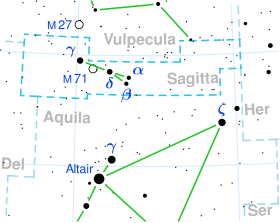S Sagittae
| Observation data Epoch J2000.0 Equinox J2000.0 (ICRS) | |
|---|---|
| Constellation | Sagitta |
| Right ascension | 19h 56m 01.26s[1] |
| Declination | +16° 38′ 05.3″[1] |
| Apparent magnitude (V) | 5.24 – 6.04[2] |
| Characteristics | |
| Evolutionary stage | Supergiant |
| Spectral type | F6Ib-G5Ib[3] |
| U−B color index | +0.6 – +0.9[2] |
| B−V color index | +0.7 – +1.0[2] |
| Variable type | Classical Cepheid[2] |
| Astrometry | |
| Radial velocity (Rv) | −9.91[4] km/s |
| Proper motion (μ) | RA: +0.375[1] mas/yr Dec.: −7.100[1] mas/yr |
| Parallax (π) | 1.6673 ± 0.1106 mas[1] |
| Distance | 2,000 ± 100 ly (600 ± 40 pc) |
| Absolute magnitude (MV) | –3.8[5] |
| Details | |
| Mass | 7[6] M☉ |
| Radius | 58.5[7] R☉ |
| Luminosity | 5,200[8] L☉ |
| Surface gravity (log g) | 1.93[1] cgs |
| Temperature | 5,400[5] K |
| Metallicity [Fe/H] | +0.1[9] dex |
| Age | 81[10] Myr |
| Other designations | |
| Database references | |
| SIMBAD | data |
S Sagittae, also known by the Flamsteed designation of 10 Sagittae, a Classical Cepheid variable in the constellation Sagitta that varies from magnitude 5.24 to 6.04 in 8.382 days.[2] Its variable star designation of "S" indicates that it was the second star discovered to be variable in the constellation. Irish amateur astronomer John Ellard Gore was the first to observe its variability in 1885, and Ralph Hamilton Curtiss discovered its changing radial velocity in 1903–04.[11] Harlow Shapley observed in 1916 that the spectrum of it and other Cepheids varied with its brightness, recording it as spectral type F0 leading to maximum, F4 at maximum, and G3 just before minimum brightness.[12]

S Sagittae is a yellow-white supergiant that varies between spectral types F6Ib and G5Ib. It is around six or seven times as massive and five thousand times as luminous as the Sun and is located around 2,000 light-years away from Earth.[2] Its radius is 58.5 times that of the Sun.[7] The radius, temperature, luminosity, and colour are all variable as the star pulsates during its eight-day period. The period is slowly increasing.[2]
S Sagittae has been reported as a double or triple system with a hotter main sequence star companion in a 676-day orbit. The companion, and its own possible fainter companion, are only detectable from radial velocity changes in the spectral lines of the Cepheid primary and an ultraviolet excess. Analysis of the spectrum indicates a star of spectral type A7V to F0V, and 1.5 to 1.7 times as massive as the Sun. However, as the mass of the companion is greater than 2.8 solar masses, this strongly suggests this companion is itself a binary star.[6]
References
- ^ a b c d e f Vallenari, A.; et al. (Gaia collaboration) (2023). "Gaia Data Release 3. Summary of the content and survey properties". Astronomy and Astrophysics. 674: A1. arXiv:2208.00211. Bibcode:2023A&A...674A...1G. doi:10.1051/0004-6361/202243940. S2CID 244398875. Gaia DR3 record for this source at VizieR.
- ^ a b c d e f g Kiss, L. L. (1998). "A photometric and spectroscopic study of the brightest northern Cepheids – I. Observations". Monthly Notices of the Royal Astronomical Society. 297 (3): 825–838. Bibcode:1998MNRAS.297..825K. doi:10.1046/j.1365-8711.1998.01559.x.
- ^ Payne-Gaposchkin, Cecilia (1984). "Der Seufzer des Fusionsofens – Die Cepheiden". Sterne und Sternhaufen (in German). pp. 96–110. doi:10.1007/978-3-322-86266-2_8. ISBN 978-3-528-08486-8.
- ^ Pourbaix, D.; Tokovinin, A. A.; Batten, A. H.; Fekel, F. C.; Hartkopf, W. I.; Levato, H.; Morrell, N. I.; Torres, G.; Udry, S. (2004). "SB9: The ninth catalogue of spectroscopic binary orbits". Astronomy and Astrophysics. 424 (2): 727–732. arXiv:astro-ph/0406573. Bibcode:2004A&A...424..727P. doi:10.1051/0004-6361:20041213. S2CID 119387088.
- ^ a b Kovtyukh, V. V.; Chekhonadskikh, F. A.; Luck, R. E.; Soubiran, C.; Yasinskaya, M. P.; Belik, S. I. (2010). "Accurate luminosities for F-G supergiants from Fe ii / Fe i line depth ratios". Monthly Notices of the Royal Astronomical Society. 408 (3): 1568. Bibcode:2010MNRAS.408.1568K. doi:10.1111/j.1365-2966.2010.17217.x.
- ^ a b Evans, Nancy R.; Welch, Douglas L.; Slovak, Mark H.; Barnes, Thomas G.; Moffett, Thomas J. (1993). "The orbit and companion of the Cepheid S SGE – A probable triple system". Astronomical Journal. 106: 1599. arXiv:astro-ph/9706292. Bibcode:1993AJ....106.1599E. doi:10.1086/116750.
- ^ a b Moskalik, P.; Gorynya, N. A. (2005). "Mean Angular Diameters and Angular Diameter Amplitudes of Bright Cepheids". Acta Astronomica. 55: 247. arXiv:astro-ph/0507076. Bibcode:2005AcA....55..247M.
- ^ McDonald, I.; Zijlstra, A. A.; Boyer, M. L. (2012). "Fundamental parameters and infrared excesses of Hipparcos stars". Monthly Notices of the Royal Astronomical Society. 427 (1): 343–357. arXiv:1208.2037. Bibcode:2012MNRAS.427..343M. doi:10.1111/j.1365-2966.2012.21873.x. S2CID 118665352.
{{cite journal}}: CS1 maint: unflagged free DOI (link) - ^ Andrievsky, S. M.; Kovtyukh, V. V.; Luck, R. E.; Lépine, J. R. D.; Bersier, D.; MacIel, W. J.; Barbuy, B.; Klochkova, V. G.; Panchuk, V. E.; Karpischek, R. U. (2002). "Using Cepheids to determine the galactic abundance gradient. I. The solar neighbourhood". Astronomy and Astrophysics. 381: 32–50. arXiv:astro-ph/0112525. Bibcode:2002A&A...381...32A. doi:10.1051/0004-6361:20011488. S2CID 15499813.
- ^ Skowron, Dorota M.; et al. (2019). "A three-dimensional map of the Milky Way using classical Cepheid variable stars". Science. 365 (6452): 478–482. arXiv:1806.10653. Bibcode:2019Sci...365..478S. doi:10.1126/science.aau3181. PMID 31371611. S2CID 199064609.
- ^ Aldrich, John A. (1932). "A study of S Sagittae". Publications of the Observatory of the University of Michigan. 4 (5): 75–92. Bibcode:1932POMic...4...75A.
- ^ Shapley, Harlow (1916). "The variations in spectral type of twenty Cepheid variables". The Astrophysical Journal. 44 (`): 273–91. Bibcode:1916ApJ....44..273S. doi:10.1086/142295.
- ^ Kiss, Laszlo L. (July 1998). "A photometric and spectroscopic study of the brightest northern Cepheids - I. Observations". Monthly Notices of the Royal Astronomical Society. 297 (3): 825. Bibcode:1998MNRAS.297..825K. doi:10.1046/j.1365-8711.1998.01559.x.

